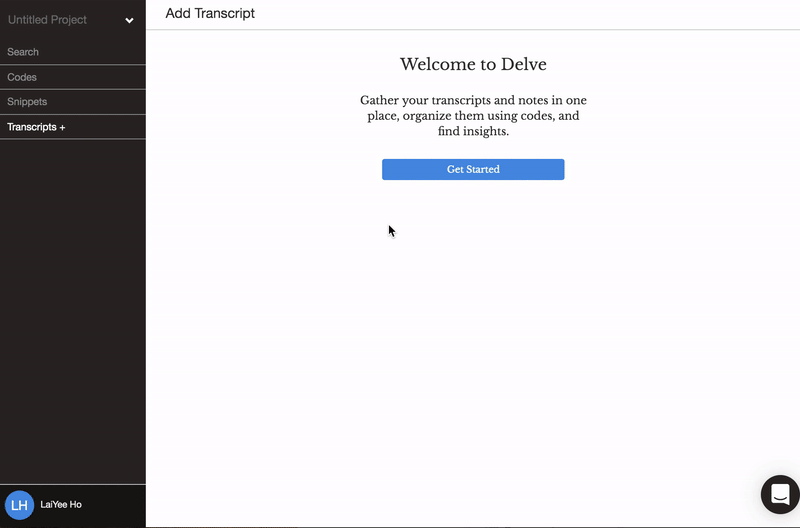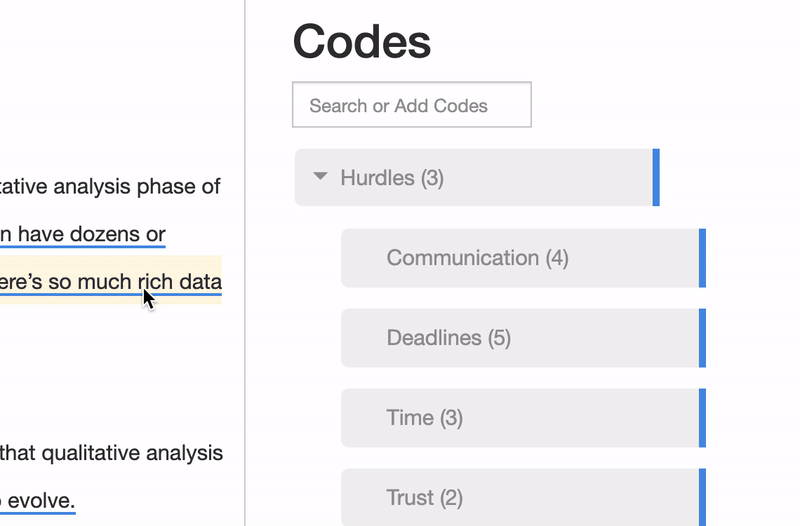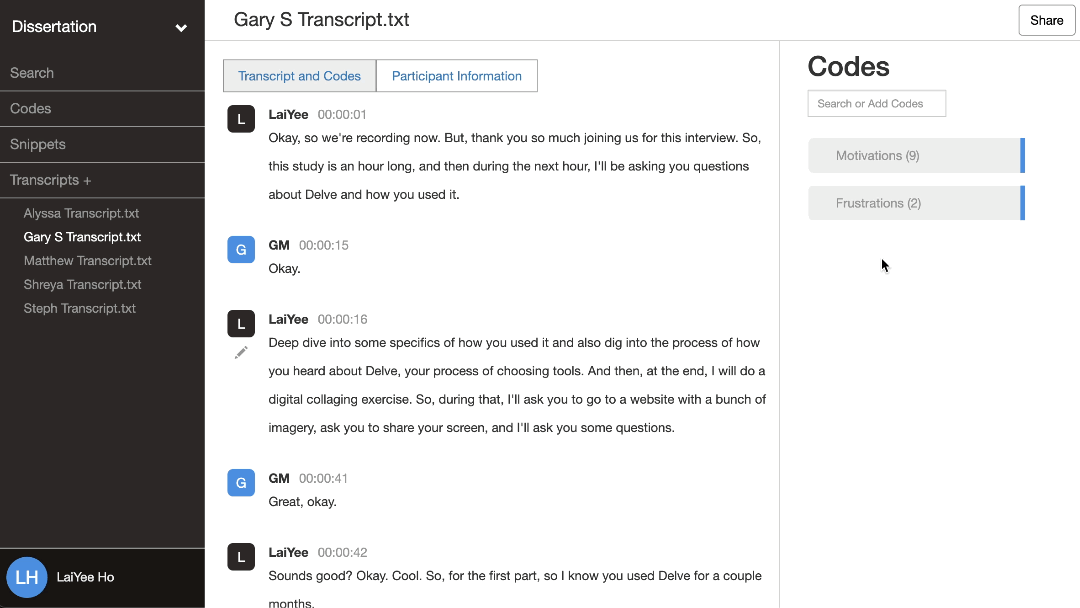How to Do Values Coding in Qualitative Research
All of your interview transcripts are packed with personal convictions, cultural influences, and deeply held beliefs. There’s plenty to learn about what people care about most, but it's easy to get overwhelmed without a reliable way to organize it all. That's where values coding comes in, helping you look beyond what participants say to identify the values, attitudes, and beliefs they express about particular topics.
In this article, we’ll explore how values coding fits into your qualitative analysis, how to keep it organized, and when to apply it in your projects. You'll also see how qualitative coding software like Delve can shorten your research timeline and free up more time for deeper analytical work.
📘 Build coding skills with confidence
New to qualitative coding or need a quick refresher? Take our free course or dive deeper with the qualitative coding guide.
What is values coding?
Values coding is a qualitative research method that helps you organize and interpret large amounts of textual data, like interview transcripts based on a participant's values, attitudes, or beliefs about a particular topic. You do this by labeling or “value coding” meaningful segments that help explain it, focusing on these three interrelated elements:
Values (what's important to someone)
Attitudes (how they feel or think about something)
Beliefs (what they accept as true, influenced by personal experiences)
Saldaña (2011) suggests these three pieces interact to form the “human side” behind people’s choices. He offers values coding as a reliable way to get to the heart of these decisions.
Your value codes either take an emic perspective (the participant's own words and viewpoint) or an etic perspective (your analytical lens as a researcher). For example, coding "I really believe in tradition" might preserve the participant's exact phrasing. You might also interpret it as "traditional view of marriage," taking an emic perspective instead. You’re capturing both what participants say directly and the underlying meanings that aren’t always obvious. Recording memos helps you keep a close eye on any fuzzy sections and track your thinking about specific codes across time.
Now that we see what values coding aims for, let's look at where it fits into the broader qualitative analysis process and how it ties into other coding methods.
💡 Coding tip: Listen for values as you collect data
During interviews, ask open-ended questions like “Why does that matter to you?” or “What’s important about…?” These often lead to responses that include:
- → “I think...”
- → “I feel...”
- → “It’s important that...”
These are clear signs of values, beliefs, and attitudes you can code later.
Where values coding fits in the broader process
Values coding happens during your initial coding rounds. During these "first-cycle coding" rounds, you're simply noticing when participants explain what they care about or how they see their world. Instead of trying to tackle dozens or hundreds of transcripts all at once, values coding helps you break all your data into meaningful (and more manageable) categories. It’s like organizing books by genre so you find what you’re looking for without reading every single title each time.
But how does value coding compare to other first-cycle methods? Other options, like emotion coding, might show that a participant feels frustrated with technology, but value coding uncovers the underlying beliefs causing that reaction. It looks for the "why" behind your data – maybe they value mastery or time efficiency. Understanding this angle early in your project sets you up for more nuanced analysis later.
Here's how value coding compares to other first-cycle approaches:
🗒️ Coding example: Different first-cycle approaches
Transcript excerpt: “Ever since the system update, I’ve been stuck redoing tasks over and over. I'm exhausted.”
| Method | What it captures | Example code |
|---|---|---|
| Values coding | Priorities, attitudes, or core beliefs | Values efficiency |
| Emotion coding | Emotional reactions and feeling states | Frustration |
| In vivo coding | Participant's exact language | "Stuck redoing tasks" |
| Process coding | Actions or ongoing behaviors | Redoing work |
| Magnitude coding | Intensity or strength of experiences | Exhaustion: High (3/3) |
Reference: Delve Qualitative Data Analysis Software
While these other approaches can capture what participants say or how they feel, values coding helps you understand the principles and attitudes that shape their entire worldview.
As you refine your codes in second-cycle methods like axial coding in grounded theory or thematic analysis, you'll see how these values connect to broader themes. The values you identify early on help build the foundation for interpreting the deeper significance behind participants' words and experiences.
Understanding how values coding helps uncover motivations behind your participants' words and actions, let's look at the best times to use this approach in a real study.
💡 Coding tip: Start with values coding
Values coding is a great starting point because it helps you focus on what matters to participants instead of jumping into your own interpretations too quickly. With Delve, you can add these codes quickly and keep moving, so you won’t get stuck overthinking early coding passes.
When to use values coding
Values coding is a first-cycle coding step when you want to explore the deeper motivations and perspectives driving your participants' responses. You should consider this approach when:
Researching cultural norms and how people adopt or question them
Studying personal decision-making processes or moral beliefs
Examining how certain social or historical contexts shape attitudes
Investigating topics with strong personal convictions, think: religion, politics, or ethics
Looking to highlight the "human side" of your data beyond just observable behaviors
If you’re studying sensitive topics, like politics or religion, this method can reveal how deeply rooted values guide participants’ perspectives. Even if they don’t state them plainly. It also pairs well with emotion coding, since beliefs tend to underpin strong emotional reactions. Depending on your research questions and goals, you can weave in other first-cycle coding approaches.
For example, in a study about work-life balance, values coding might reveal that some participants prioritize "achievement above all else" while others value "family time as sacred." These underlying values help explain the different choices people make and prioritize in similar circumstances.
💡 Coding tip: Bridging emic and etic perspectives
Value codes can reflect different perspectives:
- → Emic: the participant’s own words (“believe in tradition”)
- → Etic: your interpretation (“traditional view of marriage”)
Using both views, and tracking your thinking with reflexive memos, keeps your analysis balanced and clear.
How to do values coding: A practical guide
Before you even begin coding, you need to make sure your data collection approaches can capture values, attitudes, and beliefs. During interviews or focus groups, certain questions or pre-made prompts can help you dig into these concepts with less friction.
Asking questions that evoke values during data collection
When conducting interviews, consider using questions that naturally prompt participants to share their values, attitudes, and beliefs:
"Why does that matter to you?"
"What's important about...?"
"How do you feel about...?"
"What do you like about...?"
As participants respond, pay attention to phrases that often signal values statements:
"I feel..."
"I want..."
"I think..."
"I love..."
"I need..."
"It's important that..."
These verbal cues often introduce statements rich in values, attitudes, and beliefs that you can later code during your analysis. Now that you know what to look for in your data, let's walk through a step-by-step process for implementing values coding in your research.
💡 Coding tip: Bulk import transcripts faster
With Delve, you can bulk import transcripts and start coding right away without extra setup. Save time upfront so you can focus on analyzing, not organizing.

2. Immerse yourself in context
Before labeling anything, review your transcripts a few times. Get a sense of participants' cultural or personal backgrounds. Values, attitudes, and beliefs don’t exist in a vacuum. They’re shaped by cultural background, religion, media, and personal history. Note any standout quotes or recurring themes as you read. This helps you see how life experiences might influence why people prioritize certain things.
Jot down any standout quotes or recurring ideas that point to what people value most. You aren’t formally coding at this point. These first stages are about getting to know your data inside and out.
🗒️ Example excerpt for coding
“I grew up in a tight-knit community where everyone helped each other out.”
Potential codes: Community-driven mindset, Value of mutual support.
3. Build your initial values code list
Create a list of potential value-based codes you've noticed. These might come directly from participants' words or be your own interpretive terms. You may develop these codes inductively, by noticing themes as you read, or deductively, if you’re applying a predefined framework or theory.
Delve lets you add each code with a short definition or example excerpt for clarity in just a few clicks. Some possible values code examples include:
Belief in educational equality
Valuing community connection
Attitude toward authority
Commitment to environmental responsibility
Keep definitions brief so you can apply codes consistently. Remember, codes can be directly from the participant’s viewpoint (emic) or your interpretation (etic). If someone says, “Family always comes first,” you might keep it verbatim or interpret it as the value of family above all.
💡 Coding tip: Keep values coding flexible
Value codes can shift depending on where you are in the process.
- In early passes, keep codes short and descriptive — words or quick phrases like loyalty, personal responsibility, or belief in fairness.
- As your analysis deepens, expand them into more specific or interpretive codes like strong belief in self-discipline as moral virtue or views personal freedom as a core value.
Pair short codes with memos to keep track of deeper meanings without losing clarity.
4. Code your data with values coding
Now it's time to highlight excerpts that reveal a clear value, attitude, or belief and tag them with relevant codes. Let's look at some examples:
🗒️ Example excerpts for values coding
“Education should be free for everyone, regardless of their background.”
Potential code: Belief in equal access to education
Why it matters: Highlights a core value around fairness and opportunity.
“Family always comes first for me, no matter what.”
Potential code: Value of familial priority
Why it matters: May influence choices about work-life balance, finances, and relationships.
“I don't trust politicians. They're all looking out for themselves.”
Potential code: Skeptical attitude toward political leaders
Why it matters: Could impact civic engagement, trust in institutions, and voting patterns.
Stay flexible. If you realize halfway through that your code list needs refining, maybe two codes overlap, update them as you go. Delve’s intuitive interface makes it easy to merge or rename your codes without upfront learning, so you can adapt to new insights in a more efficient way.
💡 Coding tip: Make values coding easier
With Delve, you can highlight text and create codes with a single click. You can also merge codes or nest related codes to stay organized as your analysis grows.

5. Review and refine
Once you've applied your codes, step back and examine the connections between them. Consider:
Do certain values appear together consistently?
Is there overlap or contradiction between codes?
Are some values more prevalent in certain demographic groups?
This is where tools like Delve help you visualize patterns:
Use the co-occurrence matrix to see which codes frequently overlap.
View code pages to explore frequency counts, definitions, and linked excerpts at a glance.
Merge related codes or group them into categories for clearer analysis.
This naturally sets you up for second-cycle coding like thematic analysis and grounded theory, where you connect values to broader cultural insights. With the many benefits squared away, let’s look at a few common pitfalls and how to handle them so they don’t derail your analysis.
Common challenges with values coding
Even with a solid plan, values coding can get tricky. It’s easy to misinterpret a statement or let your personal biases sneak into the coding process. Here are some frequent obstacles and how to address them:
1. Blurring your perspective with theirs
If you’re not careful, you might confuse your interpretation of a statement with the participant’s actual beliefs. Writing memos is a simple way to clarify whether a code captures the participant’s view (emic) or your own analytical interpretation (etic). You can attach memos directly to excerpts or codes in Delve to keep this distinction clear.
2. Coding inconsistently across a team
If multiple people are coding data, everyone must agree on code definitions. Delve’s collaborative workspace is designed to let teams review each other's work, apply codes consistently, and track changes in real time from anywhere with an internet connection.
3. Being too precise, too early
It’s normal to revise or merge codes as you find new patterns. Start broad and refine your code list over time. You can easily rename, merge, or nest codes with Delve, so your structure evolves with your insights.
4. Missing key patterns
When you’re deep in coding, it’s easy to lose sight of bigger trends. Delve’s co-occurrence matrices show where codes frequently overlap, helping you spot meaningful connections that may not be obvious on a first pass.
5. Forgetting to revisit code definitions
As your understanding evolves, your interpretation of a code may shift. Delve’s code pages help you keep tabs on definitions and examples, so your team stays aligned over time.
Before moving into broader themes, take time to revisit your memos, check your code structure, and explore overlap between values. A little review now will help your second-cycle coding stay rooted in what your participants actually meant.
Bringing it all together: Letting values lead
Values coding helps you uncover the guiding principles that shape your participants’ words, decisions, and experiences. Whether you’re exploring cultural norms, ethical beliefs, or personal motivations, this method gives you a framework for interpreting why people think and act as they do.
Stay close to their words: Emic codes preserve participant language and keep your analysis grounded in their perspective.
Recognize your own lens: Etic codes allow you to interpret deeper meanings, and memos help ensure you’re transparent about that process.
Start broad, refine later: It’s easier to begin with general categories and then split or merge them as you see more patterns.
Using Delve to manage these steps keeps you focused on the deeper insight, rather than juggling endless documents or code lists. With features like collaborative coding, nesting codes, and two-click coding, you’ll have a clear view of how values overlap and influence each other.

Streamline Your Thematic Analysis with Delve | Top-Rated by Researchers ⇒
Rated as a top qualitative coding software on Capterra, Delve simplifies the entire process, making it easier to uncover patterns, collaborate, and produce insights that matter.
Get 14 Days FreeNo commitment. Cancel anytime.
See what Delve users are saying
Students and educators alike give Delve high marks across the board.
References:
Saldaña, J. (2009). The coding manual for qualitative researchers. Sage Publications Ltd.
Cite This Blog Article:
Delve, Ho, L., & Limpaecher, A. (2025, April 29). How To Do Values Coding in Qualitative Research https://delvetool.com/blog/valuescoding







